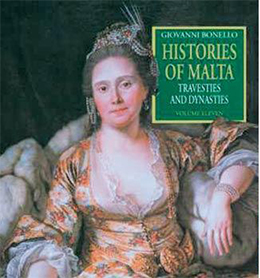Those who were struck by the graceful prose and clear thinking of Judge Giovanni Bonello’s decision in the case of the Italian crucifix (see “Keeping History,” Cultural Revolutions, July) should be interested to learn that he has for some years had a sideline in the brief historical essay. Many of these have found their way into local newspapers and into Treasures of Malta, a journal of art and culture published three times per year by Fondazzjoni Patrimonju Malti. In 2000, the foundation began issuing Histories of Malta, magnificently produced bundles of Bonello’s essays, the annual appearances of which have gathered a dedicated following for those with an interest in Maltese history in particular and good prose in general.
Bonello writes like an intelligent raconteur on the corners and byways of Maltese history. This is not so limiting as geography alone might suggest. The islands of Malta, beleaguered hub in the spoked wheel of Mediterranean naval routes, blessed with a well-sheltered deep-water harbor, have been invaded and inhabited by Phoenicians, Carthaginians, Romans, Arabs, Normans, Spaniards, the Knights of St. John, the French, and the British; Malta would have been German territory as well had not the British and Maltese endured the long siege in 1943. Malta was communally awarded the George Cross for her actions. She is also noteworthy for the Great Siege of Malta of 1565, wherein her citizens and the Knights of St. John held back the Ottoman forces of Suleiman the Magnificent in what can be considered the Ottoman Gettysburg. Malta was granted independence in 1964 and became a republic in 1974.
Clearly, any country with that kind of background is going to toss up a good deal of historical oddities of greater or lesser importance. Bonello seems interested in them all. He is a self-described archive junkie (the volume under review has an essay on this); in feeding his habit, he has brought to light much that others would consider useful only to junior faculty desperate to be published. The heart sinks on contemplating such topics as “Duelling in Malta in the Early British Period,” or “Kalkara and Birzebbuga in Early Postcards.”
Happily, the heart in this case is mistaken. There is serious scholarship here, and rigorously footnoted, but lightly displayed and delightfully written. It is Bonello’s gift to take the tedious sounding, the outré, or the unlikely, and charm them into life.
The most recent volume is as packed with treasures as its predecessors. In addition to the above, we learn some unsavory details concerning Napoleonic Gen. Anne Jean Marie René Savary, 1st Duc de Rovigo, who was in charge at Vincennes when the Duc d’Enghien, last of the Bourbon line, was dragged from his cell and summarily executed. Savary’s life postwar included a stint in jail (1815-16) at Manoel Island at Malta, as a guest of the British government. Bonello goes back to the original sources and writes tellingly of the general’s “escape.”
The author devotes another essay to the Christian relics of Malta, which recounts the odd and entertaining diplomatic attempts by both the pope and the king of France to get custody of the bones of Saint Euphemia from the Grand Master Wignacourt of the Knights of St. John.
He writes of Gen. Thomas Maitland, a British officer and, from 1811 to 1824, governor of Malta. This younger son of the seventh earl of Lauderdale was famous as the failed negotiator between England and Toussaint L’Ouverture, and for a scandalous career as governor of Ceylon. Bonello focuses on his time at Malta, where he became known as King Tom for his high-handed use of office and rather too free distribution of official favors. He died scandalously in bed with his mistress, Martha Le Mesurier. A thoroughly disgraceful individual and, of course, all the more interesting for that.
A word of warning: The first six volumes are long sold out, and the secondary market is competitive. No surprise there. The production value—sewn binding, heavy glossy paper, and well-chosen and abundant four-color illustrations—is very high indeed and, matched by that of the prose style, a pleasure to be returned to again and again.
[Histories of Malta—Travesties and Dynasties, Vol. 11, by Giovanni Bonello (Malta: Fondazzjoni Patrimonju Malti) 246 pp., €49.00]

Leave a Reply